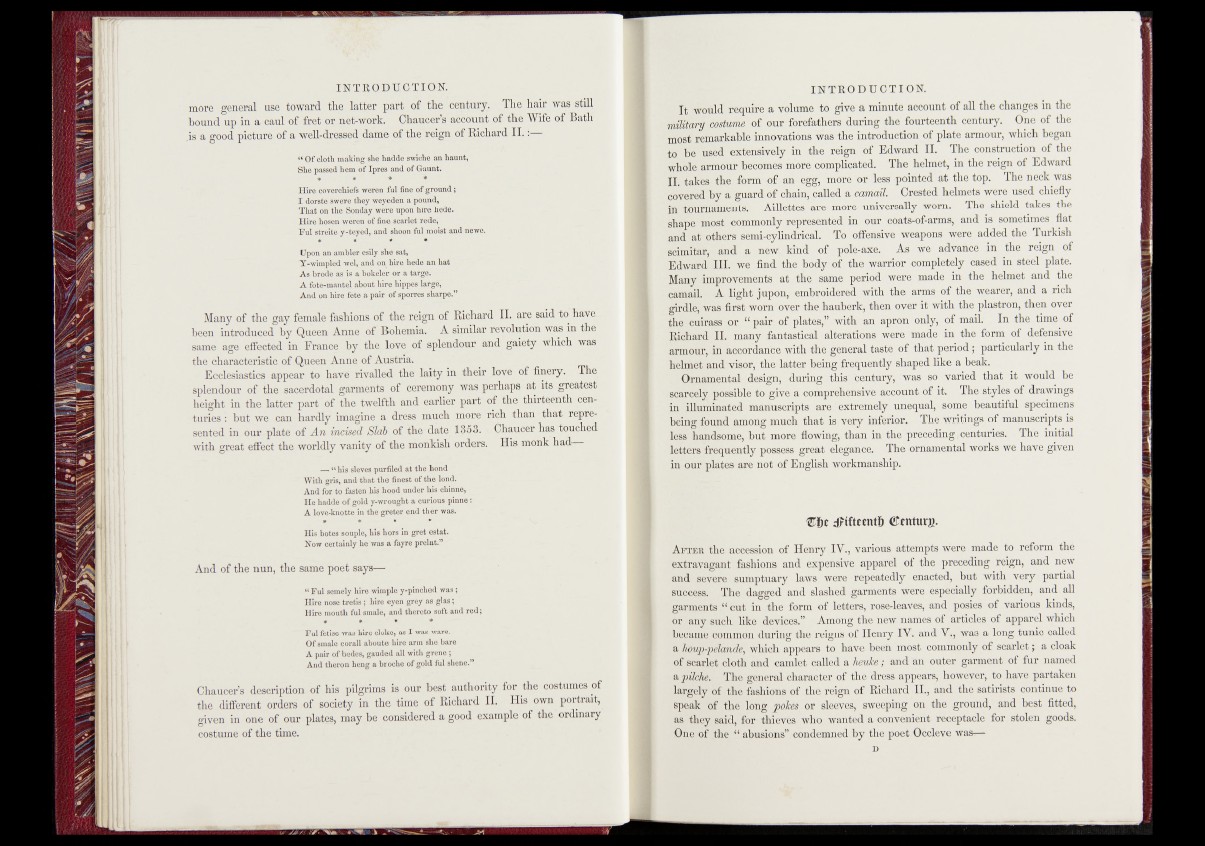
more general use toward the latter part of the century;. The hair, was still,
bound up in a caul of fret or net-work. Chaucer’s account of the Wife of ‘Bath
,is a good picture of a well-dressed dame of the reign of Richard II. :
•“ Of cloth mating she hadde swiuhe an haunt,
She passed hem of Ipres and Of Gaunt. .
Hire coverohiefs weren ful fine of ground ;
I dorste swere they weyeden a pound,
That on the Sonday were upon hire hede.
Hire hosen wéren of fine scarlet rede,
• Ful streite y-teyed, and shoon fill moist and newe.
Upon an ambler esily she sat,
Y-wimpled wel, and on hire hede an hat
As brode as is a bokeler or a targe.
A fote-manteLabout hire hippes large,
And on hire fete a pair of sporres sharpe.”
Many of the gay female fashions of the reign of Richard II. are said to have
been introduced by Queen Anne of Bohemia. A similar, revolution was in the
same age effected in France by the love of splendour and gaiety which was
the characteristic of Queen Anne of Austria.
Ecclesiastics appear to have" rivalled the laity in their love of finery. The
splendour of the sacerdotal garments of' ceremony, was perhaps at its greatest
height in the latter part of the twelfth and earlier part of the thirteenth centuries
: but we can hardly imagine a dress much more rich than'that represented
in our plate of A n incised Slab of ih e 'd ^ ' I f # i Chaucer has touched
with great effect the worldly vanity of the monkish orders. His monk had-
- — “ his sieves purfiled at the bond
" With gris, and that the finest of the lend. ‘
And for to fasten his hood under his chinne,
He hadde of gold y-wrought a curious pinne :
A love-knotte-in the greter end ther was,
His botes souple, his hors in gret estât.
How certainly he was a fayre prélat.”
And of the nun, the same poet says—
“ Ful semely hire wimple y-pinched was ;
Hire nose tretis ; hire eyen grey as glas ;
Hire mouth ful smale, and thereto soft and red;
Ful fetise was hire cloke, as I was ware.
Of smale corail aboute hire arm she bare
A pair of bedes, gauded all with grene ;
And theron heng a broche of gold ful shene.”
Chaucer’s description of his pilgrims is our best authority for the costumes of
the different orders of society in the time of Richard II. His own portrait,
given in one of our plates, may bè considered a good example of the ordinary
costume of the time.
It would require a volume to give a minute account of all the changes in the
military) cdstume of our-forefathers during the fourteenth century. One of the
most remarkable innovations was the introduction of plate armour, which began
to be used extensively in the reign of Edward II. The construction of the
whole armour bècoines more complicated. The helmet, in the reign of Edward
II. takes the form of an egg, more or less pointed at the top. The neck was
covered by a guard of chain, called a carnüiî. Crested helmets were used chiefly
in tournaments. AiUettes. are more universally worn. The shield takes the
shape most commonly represented in our coats-of-arms, and is sometimes flat
and atl,others semi-cylindrical. To offensive weapons were added the Turkish
scimitar, and à nèw. kind of pole-axe. As we. advance in the reign of
Edward III. we find ihe warrior completely cased in steel plate.
Many improvements at the same period were made in the helmet and the
Aftrrmil A light jupon, embroidered with the .arms of the wearer, and a rich
girdle, was first worn ov$r -the hauberk, then over it? with the plastron, .then over,
the cuirass or “ pair of plates,” with an apron o i® | of maiL In the time of
Richard II. many fantastical alterations were made in form of defensive
armour, in accordance with general taste of that period ; particularly in the
helmet and visor, the -latter being frequently shaped like a beak.
Ornamental design, during this century, was so varied that it would be
scarcely pôssible to give a comprehensive account ,of it. The stylés, of drawings
in illuminated manuscripts are, extremely unequal, some beautiful specimens
being found among much that is Vcty inferior. The -writings of manuscripts is
less handsome, but more flowing, than in the preceding ^centuries. The, initial
letters frequently possess, great elegance. The ornamental works we have given
in our plates are not of English workmanship.
Htf)t dfifttenth CJfttturg.
After thé accession of Henry IV., various attempts were. made to reform thé
extravagant fashions and expensive apparel of the preceding reign, and new
and severe sumptuary laws were repeatedly enacted, but with very partial
success. The dagged and slashed garments were especially forbidden, and all
garments “ cut in the form of letters, rose-leaves, and posies of various kinds,
or any such like devices.” Among the new names of articles of apparel which
became common during the reigns of Henry IV. and V., was a long tunic called
a kóup-pelande, which appears to have been most commonly of scarlet; a cloak
of scarlet cloth and camlet called a heuke; and an outer garment of fur named
&pilche. The general character of the dress appears, however, to have partaken
largely of the fashions of the reign of Richard I I, and the satirists continue to
speak of the long pokes or sleeves, sweeping on the ground, and best fitted,
as they said, for thieves who wanted a convenient receptacle for stolen goods.
.One of .the “ abusions” condemned by the poet .Occleve wa*—
D